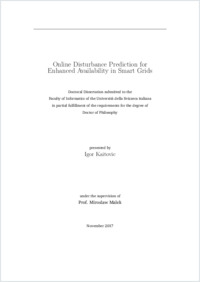Online disturbance prediction for enhanced availability in smart grids
- Kaitovic, Igor
- Malek, Miroslaw (Degree supervisor)
-
25.10.2017
155 p
Thèse de doctorat: Università della Svizzera italiana, 2017
Active distribution networks
Availability
Data analytics
Dependability
Disturbances
Fault injection
Machine learning
Prediction
Proactive management
Simulation
Smart grid
Voltage sags
English
A gradual move in the electric power industry towards Smart Grids brings new challenges to the system's efficiency and dependability. With a growing complexity and massive introduction of renewable generation, particularly at the distribution level, the number of faults and, consequently, disturbances (errors and failures) is expected to increase significantly. This threatens to compromise grid's availability as traditional, reactive management approaches may soon become insufficient. On the other hand, with grids' digitalization, real-time status data are becoming available. These data may be used to develop advanced management and control methods for a sustainable, more efficient and more dependable grid. A proactive management approach, based on the use of real-time data for predicting near-future disturbances and acting in their anticipation, has already been identified by the Smart Grid community as one of the main pillars of dependability of the future grid. The work presented in this dissertation focuses on predicting disturbances in Active Distributions Networks (ADNs) that are a part of the Smart Grid that evolves the most. These are distribution networks with high share of (renewable) distributed generation and with systems in place for real-time monitoring and control. Our main goal is to develop a methodology for proactive network management, in a sense of proactive mitigation of disturbances, and to design and implement a method for their prediction. We focus on predicting voltage sags as they are identified as one of the most frequent and severe disturbances in distribution networks. We address Smart Grid dependability in a holistic manner by considering its cyber and physical aspects. As a result, we identify Smart Grid dependability properties and develop a taxonomy of faults that contribute to better understanding of the overall dependability of the future grid. As the process of grid's digitization is still ongoing there is a general problem of a lack of data on the grid's status and especially disturbance-related data. These data are necessary to design an accurate disturbance predictor. To overcome this obstacle we introduce a concept of fault injection to simulation of power systems. We develop a framework to simulate a behavior of distribution networks in the presence of faults, and fluctuating generation and load that, alone or combined, may cause disturbances. With the framework we generate a large set of data that we use to develop and evaluate a voltage-sag disturbance predictor. To quantify how prediction and proactive mitigation of disturbances enhance availability we create an availability model of a proactive management. The model is generic and may be applied to evaluate the effect of proactive management on availability in other types of systems, and adapted for quantifying other types of properties as well. Also, we design a metric and a method for optimizing failure prediction to maximize availability with proactive approach. In our conclusion, the level of availability improvement with proactive approach is comparable to the one when using high-reliability and costly components. Following the results of the case study conducted for a 14-bus ADN, grid's availability may be improved by up to an order of magnitude if disturbances are managed proactively instead of reactively. The main results and contributions may be summarized as follows: (i) Taxonomy of faults in Smart Grid has been developed; (ii) Methodology and methods for proactive management of disturbances have been proposed; (iii) Model to quantify availability with proactive management has been developed; (iv) Simulation and fault-injection framework has been designed and implemented to generate disturbance-related data; (v) In the scope of a case study, a voltage-sag predictor, based on machine- learning classification algorithms, has been designed and the effect of proactive disturbance management on downtime and availability has been quantified.
- Language
-
- English
- Classification
- Computer science and technology
- License
-
License undefined
- Identifiers
-
- RERO DOC 306085
- URN urn:nbn:ch:rero-006-116722
- ARK ark:/12658/srd1318862
- Persistent URL
- https://n2t.net/ark:/12658/srd1318862
Statistics
Document views: 318
File downloads:
- Texte intégral: 225
